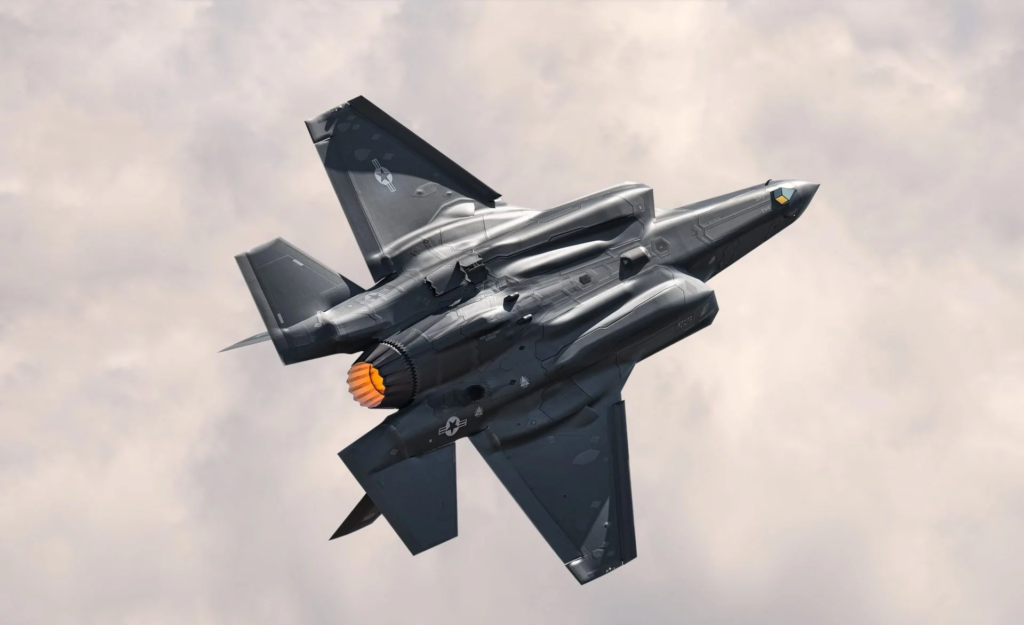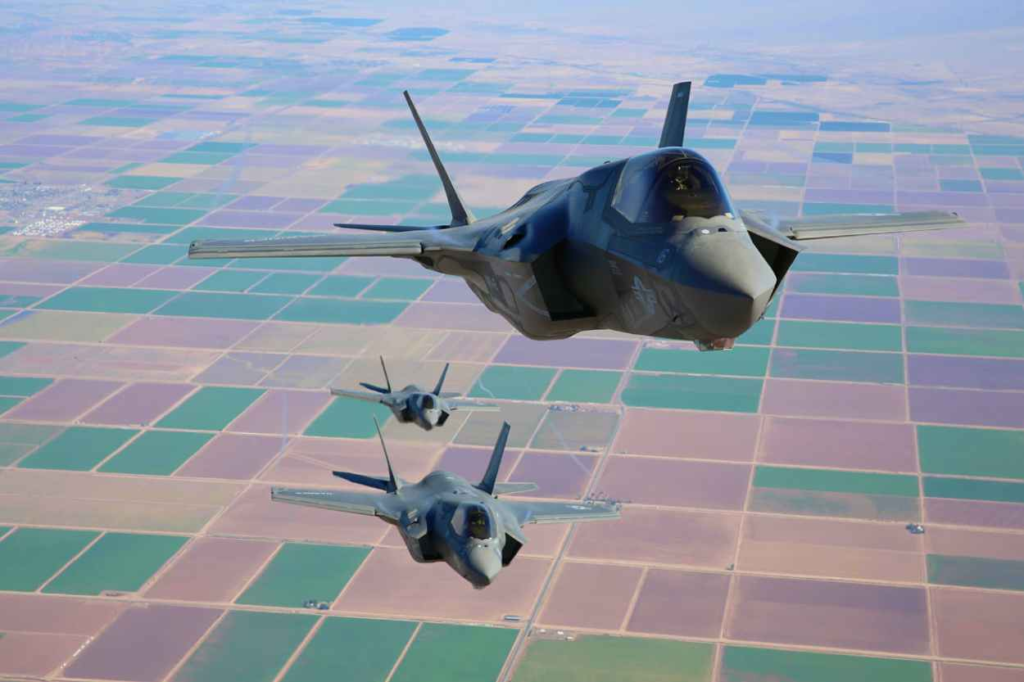
While the 5th-generation fighter F-35 is now in bigger demand by the US Air Force and the American allies all over the world for its formidable combination of stealth, advanced sensors, and weapons systems, it seems to be increasingly difficult for its manufacturer Lockheed Martin to meet the demand with a cap of 156 aircraft produced for the year.
Advertisement
The problem is further compounded by the growing supply chain hurdles, limited infrastructures at the production centers, and delayed engine-overhaul programs.
Let us see the demand side first. It is reported that the US military, in its fiscal year 2024 plan, has indicated buying 83 F-35s — 48 for the Air Force, 19 for the Navy, and 16 for the Marine Corps. The Air Force is to buy 48 a year till 2028, and beyond that, it is said to be planning to buy 980 F-35s in total to reach its desired goal of 1,763 fighters.
The US Air Force is reluctantly going for only 48 F-35s. It is said to have originally planned to buy 110 F-35s a year, a figure later reduced to 80, then 60, and in recent years to 48. It is unhappy as its strength has dwindled from 4,556 aircraft in 1990 to 2,176 today—and will continue to fall, as “USAF is retiring 801 fighters and only buying 345 through 2028”.
Regarding American allies and partners, Finland and Switzerland decided to buy 100 F-35s the past year, while Canada ordered 88 jets. Germany also has been approved for F-35 acquisition, and countries including Greece and the Czech Republic have entered into negotiations with Lockheed Martin after selecting the F-35 to replace fighters in their current fleets.
Additional Read: F-35s For India: US Stealth Fighters Good Interim Investment For Indian Air Force To Counter Growing Chinese J-20 Numbers: Opinion
Israel said on July 2 it would buy an additional 25 aircraft on top of the 50 it had already purchased. The Czech Republic also said last fortnight that it would buy 24 F-35s, which will replace the Saab JAS-39C Gripen fighters the Czechs have been leasing.
Over the last year, if one considers the orders of F-35s from Finland, Switzerland, Germany, and now the Czech Republic, the number goes to 159 F-35s, which is higher than the permitted production- quota of 156.
This figure, incidentally, does not include orders from Poland, which ordered 32 of the fighters in 2020, and Greece, which intends to buy 20-24 F-35s, but the formal application for which has not been completed.
It may be noted here that old or pending orders were signed years ago. Lockheed is supposed to keep its commitment to supply within the agreed schedules. These orders involve those from Belgium, Denmark, Italy, Norway, and the UK that fly F-35s. Asian customers, such as Japan, South Korea, and Singapore. This entire backlog needs to be cleared.
Advertisement

Overall, thus, one can say that the market of the F-35s is robust and growing. So far, 17 countries are its customers. And this is said to be propitious for the US aerospace industry. The US also gains access to lucrative maintenance and training markets.
A study commissioned by Lockheed Martin estimates that with an aggregate economic impact of $72 billion annually, the F-35 program is a boon to aerospace suppliers. These suppliers conduct numerous activities, including production, maintenance, engineering, training, and supply chain management.
Strategically speaking, the program strengthens American security ties to nations that operate the F-35 and can include them in training exercises. In fact, in the wake of the Russian invasion of Ukraine, the F-35 market has strengthened the ties among NATO countries. Thus, the F-35 is essentially “in the center of a Venn diagram of hard power and soft power,” it is said.
Additional Read: US Confirms ‘Highly Classified’ Electronic Warfare (EW) Suite For F-35 Stealth Fighter’s Block 4 Upgrade
However, the pertinent question is the challenges that Lockheed faces in meeting the demands.
Andrew Philip Hunter, assistant secretary of the US Air Force for acquisition, technology, and logistics, told the Senate Armed Services Committee in April that Lockheed would be “very stressed” to produce more than 156 aircraft annually. Producing more than that would mean “we would probably have to increase tooling” and add more shifts of workers, which have been hard for Lockheed to hire, Hunter said.
Hunter also admitted that the center body of the aircraft is a “significant limiter,” as Northrop Grumman builds the center body of the F-35 at its Palmdale, California, facilities, where it also builds the B-21 bomber and lacks the room to expand and accommodate.
Apparently, Lockheed had an understanding with Turkey to produce a substantial number of the center body assemblies for the international market. However, that is not relevant now as it has been drummed out of the F-35 program following its decision to buy Russian S-400 air defense systems.
Similarly, Lockheed has a deal with Rheinmetall of Germany to produce F-35 center fuselages, but the exact production timing is uncertain.
According to Air Force Lt. Gen. Michael Schmidt, the current head of the F-35 Joint Program Office (JPO), the biggest risk is that F-35 units have little in terms of spare parts on the shelf.
He apprehends that aviation units often are not prepared to deploy and operate very complex aircraft like the F-35 from a wide variety of sites that the US military has encouraged to be set up to reduce vulnerability and upend enemy planning cycles. As a remedial measure, he would like an arrangement so that the US military purchases, stockpiles, and distributes F-35 spare parts.
Last but not least, every cycle of F-35 production sees a “technical refresh” and “upgrades” of various parts and components to retain the edge over the competitors. And it takes additional money and increases the costs. For instance, F-35 engines are being overworked and could lead to an extra $38 billion in overhauls in the next few decades to help cool radar and other components of the fighter jets.
Advertisement

Auditors from the US Government Accountability Office (GAO), in their recently released 91-page report, said in its 91-page annual report, “The cooling system is overtasked, requiring the engine to operate beyond its design parameters. The extra heat is increasing the wear on the engine, reducing its life, and adding $38 billion in maintenance costs.”
It is said that the F-35s’ power and thermal management system, or PTMS, cools the parts of the aircraft’s systems that generate heat. The management system transfers pressure from the fighter jet’s single engine to cool other components. However, the more air pressure transferred, the hotter the engine gets.
“The PTMS, however, needs more air pressure from the engine to cool subsystems than originally anticipated, which is reducing the life of the engine,” the GAO wrote. However, the point is that Honeywell designs the F-35’s PTMS. And the delay here is adversely affecting the scheduled production of the aircraft.
However, Lockheed officials say they will rise to the challenges and boost production by measures they have started undertaking. The company plans to turn out its 1,000th F-35 fighter by the end of this year on the one-mile, 20-foot-long assembly line at Air Force Plant 4 (FORT WORTH, Texas), from which planes have rolled off since the B-24 Liberator bomber in 1942.
“We just crossed 900 airplanes delivered,” Edward “Stevie” Smith, Lockheed Martin’s director of F-35 domestic business development and a retired Navy F/A-18 pilot, said on April 12. “We should hit 1,000 at the end of the year–another great milestone for the program.”